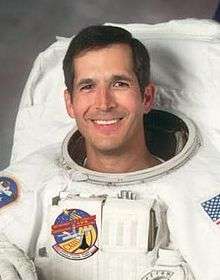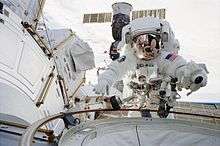John Herrington
| John Bennett Herrington | |
|---|---|
 Herrington in November 2009 | |
| NASA Astronaut | |
| Nationality | American |
| Status | Retired |
| Born |
September 14, 1958 Wetumka, Oklahoma, United States |
Other occupation | U.S. naval pilot, test pilot |
| Rank | Commander, USN |
Time in space | 13d 18h 47m[1] |
| Selection | 1996 NASA Group |
| Missions | STS-113 |
Mission insignia |
 |
John Bennett Herrington (born September 14, 1958 in Chickasaw Nation) is a retired United States Naval Aviator and former NASA astronaut. In 2002, Herrington became the first enrolled member of a Native American tribe to fly in space. (William R. Pogue was of Choctaw ancestry and was a crewman aboard Skylab 4 in 1973–1974, but he was not an enrolled member of the Choctaw.)
Early life
Herrington was born in Wetumka, Oklahoma into the Chickasaw Nation. He grew up in Colorado Springs, Colorado, Riverton, Wyoming, and Plano, Texas, where he graduated from Plano Senior High School. He earned a bachelor's degree in applied mathematics from the University of Colorado Colorado Springs before receiving his commission in the United States Navy in 1984.
To honor his Chickasaw heritage, Herrington, an enrolled member of the Chickasaw Nation, carried its flag on his thirteen-day trip to space. The flag had been presented to him by Chickasaw Nation Governor Bill Anoatubby.
United States Navy career
Herrington received his commission in the U.S. Navy from the Aviation Officer Candidate School at Naval Air Station Pensacola, Florida in March 1984. In March 1985 he was designated a Naval Aviator and proceeded to Patrol Squadron Thirty-One (VP-31) at Moffett Field, California for training in the P-3C Orion. His first operational assignment was with Patrol Squadron Forty-Eight (VP-48) where he made three operational deployments, two to the Northern Pacific-based from Naval Air Facility Adak, Alaska and one to the Western Pacific-based from the Naval Air Station Cubi Point, Philippines. While assigned to VP-48, Herrington was designated a Patrol Plane Commander, Mission Commander, and Patrol Plane Instructor Pilot.
Following completion of his first operational tour, Herrington returned to VP-31 as a Fleet Replacement Squadron Instructor Pilot. While assigned to VP-31, he was selected to attend the United States Naval Test Pilot School at Naval Air Station Patuxent River, Maryland in January 1990. After graduation in December, 1990, he reported to the Force Warfare Aircraft Test Directorate as a project test pilot for the Joint Primary Aircraft Training System. Herrington conducted additional flight test assignments flying numerous variants of the P-3 Orion as well as the T-34C and the de Havilland Canada Dash 7. Following his selection as an Aeronautical Engineering Duty Officer (AEDO), Herrington reported to the U.S. Naval Postgraduate School, where he attained a Master of Science degree in aeronautical engineering in June 1995. Herrington was assigned as a special projects officer to the Bureau of Naval Personnel Sea Duty Component when selected for the astronaut program.
During his military service, he was awarded the Navy Commendation Medal, Navy Meritorious Unit Commendation, Coast Guard Meritorious Unit Commendation, Coast Guard Special Operations Service Ribbon, National Defense Service Medal, Sea Service Ribbons (3), and various other service awards.
NASA career
Selected by NASA in April 1996, Herrington reported to the Lyndon B. Johnson Space Center in August 1996. He completed two years of training and evaluation, and qualified for flight assignment as a mission specialist. Herrington was assigned to the Flight Support Branch of the Astronaut Office where he served as a member of the Astronaut Support Personnel team responsible for Shuttle launch preparations and post-landing operations.
Spaceflight

Herrington was selected as a Mission Specialist for STS-113, the sixteenth Space Shuttle mission to the International Space Station. Endeavour was launched from Kennedy Space Center on November 23, 2002 to deliver the P1 Truss segment, which provides structural support for the Space Station radiators. Endeavour also delivered a new Expedition 6 crew to the Station, returning to Earth on December 7, 2002 with the Expedition 5 crew ending their 6-month stay in space. The total mission duration was 13 days, 18 hours and 47 minutes.
During the mission Herrington performed three spacewalks, totaling 19 hours and 55 minutes.
Underwater laboratory
In July 2004, Herrington served as the commander of the NEEMO 6 mission aboard the Aquarius underwater laboratory, living and working underwater for ten days.[2]
Herrington retired from the Navy and NASA in July 2005.
Rocketplane
In September 2005, Herrington resigned from NASA to become Vice President/Director of flight Operations for Rocketplane Limited, Inc., where he replaced Mitchell Burnside Clapp. He was also to serve as the pilot of the XP Spaceplane. Herrington also provides part-time support for the Center for Space Studies at the University of Colorado at Colorado Springs.
In December 2007, Herrington resigned from Rocketplane, and stated that he plans to continue doing public speaking engagements as well as work with the Chickasaw Nation.[3]
Cross-country bike ride
In 2008 Herrington embarked on a cross-country bicycle ride through the United States from Cape Flattery, Washington to Cape Canaveral, Florida. The ride took three months, from August 13 to November 15, 2008.[4]
Honors and Education
Herrington was inducted into the Chickasaw Hall of Fame in 2002.[5] He earned his PhD in education from the University of Idaho in 2014 [6]
References
![]() This article incorporates public domain material from the National Aeronautics and Space Administration document "Astronaut Bio: John Bennett Herrington (8/2005)" (retrieved on January 15, 2012).
This article incorporates public domain material from the National Aeronautics and Space Administration document "Astronaut Bio: John Bennett Herrington (8/2005)" (retrieved on January 15, 2012).
- ↑ Astronaut Bio: John Bennett Herrington (8/2005)
- ↑ NASA (August 3, 2004). "NEEMO 6". NASA. Retrieved September 23, 2011.
- ↑ "Former astronaut resigns from Rocketplane". NewsOK.
- ↑ Travel blog
- ↑ Chickasaw Hall of Fame
- ↑ From Space to Indigenous Ancestral Engineering: Commander John Herrington Charts New Territory
External links
- Rocketrek
- Herrington's Homepage
- John Herrington Profile and Videos - Chickasaw.TV
- NASA Biography
- Spacefacts biography of John Herrington
- University of Colorado Alumni News